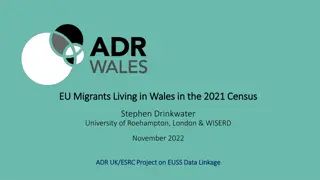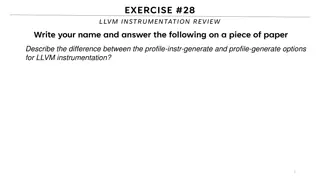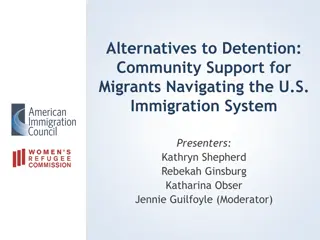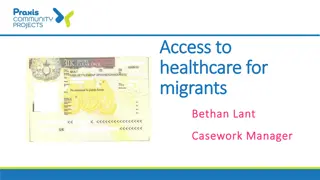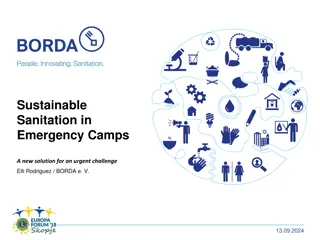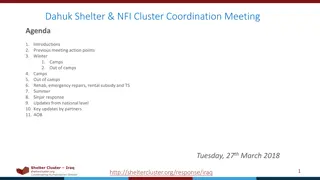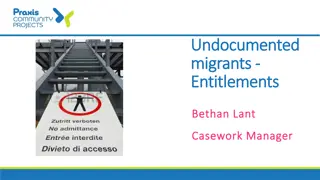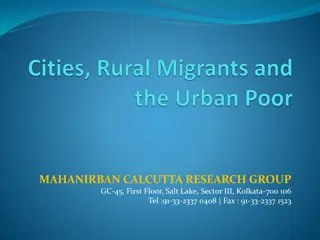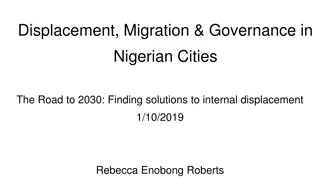Profile and Future of Migrants in Paris Emergency Camps
French Government's policies on migration crisis led to closure of 31 camps in Paris, impacting over 21,000 migrants. This study analyzes the profiles of migrants in emergency accommodations and those who have left voluntarily or by expulsion.
Download Presentation

Please find below an Image/Link to download the presentation.
The content on the website is provided AS IS for your information and personal use only. It may not be sold, licensed, or shared on other websites without obtaining consent from the author.If you encounter any issues during the download, it is possible that the publisher has removed the file from their server.
You are allowed to download the files provided on this website for personal or commercial use, subject to the condition that they are used lawfully. All files are the property of their respective owners.
The content on the website is provided AS IS for your information and personal use only. It may not be sold, licensed, or shared on other websites without obtaining consent from the author.
E N D
Presentation Transcript
PROFILE AND FUTURE OF MIGRANTS IN PARIS EMERGENCY CAMPS (JUNE 2015 - NOVEMBER 2016) 14th European Research Conference on Homelessness Septembre 20, 2019 milie Segol
INTRODUCTION In spring 2015, the French Government adopted administrative support and accommodation policies in an attempt to provide an answer to the migration crisis that had sprung a few years before This resulted in successive closing of 31 migrants camps in Paris between June 2015 and November 2016 - representing 21,241 people evacuated (Ministry of Interior s data) Migrants were brought by bus from camps to 266 emergency accommodations in the Paris area By July 2017, a part of this sheltered population was no longer in the accommodation facilities: some had already been directed to the regular facilities or granted asylum, others had left voluntarily the shelters or been excluded Is there any difference between the profile of migrants who are still in emergency accommodations and the ones who have left? Among migrants who are no longer in accommodation facilities, do migrants who left emergency accommodations voluntarily or after an expulsion have a different profile from the ones who ha been directed to the regular facilities ?
DATA : SOURCE, CONTENTS AND LIMITS Data used in this research are coming from the organisation Habitat et Interventions Sociales commissioned by the French administration to monitor the progress of migrants administrative requests Data refers to 14 214 migrants who have been sheltered in emergency accommodations between June 2015 and November 2016. Those dates correspond to the first evacuation of migrants living in Paris North camps and the opening of a dedicated center, providing emergency accommodation and administrative support to migrant newcomers. Fully anonymised data provides information on both demographic characteristics and the last known administrative situation of migrants The database does not include : Migrants from camps who refused to take buses during evacuations Migrants from camps who left accommodations before the census
METHOD Data used include a variety of socio-demographic characteristics as well as the type of administrative process through which each of the individuals in the database has to go through in order to be granted asylum. The analyses start with a description of the distribution of each of the characteristics among migrants who are still sheltered in an emergency accommodation by July 2017, those who have already been directed to the regular accommodation system, and those who have either left voluntarily or been excluded. We then test for the significant impact of gender, age, citizenship on the probability to have left the emergency accomodation before the end of the asylum seeking process, using a logistic regression. The models also include controls for the different waves of camps evacuation (held between June 2015 and November 2016).
ARE MIGRANTS STILL SHELTERED OR HAVE THEY ALREADY LEFT ? STATUS IN JULY 2017 ? 14,214 migrants brought from camps to emergency accommodations between June 2015 and November 2016 have been identified By July 2017, two-thirds (67.1 %) of this sheltered population was no longer in accommodation facilities The vast majority of migrants still in the accomodation facility (65.9%) by July 2017 are still undergoing the asylum application process, and 23.8% have already been granted asylum Migrants no longer in the accommodation facilities by July, 2017 n=9,533 Migrants still in the accomodation facility by July, 2017 n=4,681 Administrative status not yet known 2.2% Directed to the National Reception Scheme 41.9% Directed to an accommodation outside Paris area Asylum application to be registered 3.9% 2.9% Prefecture appointment 39.1% Directed to minors facilities 0.2% Asylum application in course of examination 21.2% International protection 7.7% Directed to the National Reception 5.6% Voluntary leaving 43.2% International protection 23.8% Excluded 4.0% Others 4.2% 0% 20% 40% 60% 0% 20% 40% 60%
GENDER AND AGE OF MIGRANTS ACCORDING TO THEIR ACCOMMODATION STATUS IN JULY 2017 Migrants who have been sheltered in accommodation facilities are almost exclusevily men (95.7%), both among the migrants no longer in the accommodation facilities and those who are still in the accommodation facilities by July 2017 Nearly one out of two people (48.1%) is aged between 18 and 24, both among migrants who are still in the emergency centers (48.3%) and those who have left (48.0%) A few minors have been identified (1.4%) 100% 4.2% 4.3% 4.3% 100% 7.2% 7.3% 7.4% 10.0% 10.2% 10.0% 80% 80% Frequency (%) Frequency (%) 32.9% 33.1% 33.4% 60% 60% 95.8% 95.7% 95.7% 40% 40% 20% 48.0% 48.1% 48.3% 20% 1.7% 1.4% 0.9% 0% 0% Migrants no longer in the accomodation facility by July, 2017 n=9,463 Migrants still in the accomodation facility by July, 2017 n=4,666 Total Migrants no longer in the accomodation facility by July, 2017 n=8,903 Migrants still in the accommodation facility by July, 2017 n=4,531 Status Total n=14,129 n=13,434 Status <18 18-24 25-29 30-34 35 + Male Female Non-response : n=86 (0.6%) Non-response : n=780 (5.5%)
CITIZENSHIP OF MIGRANTS ACCORDING TO THEIR ACCOMMODATION STATUS IN JULY 2017 A large part of migrants are Sudan nationals (48.1%), followed by Afghans (29.9%) Distributions of citizenships among migrants who are still in accommodation facilities and the ones who have left appears to be similar 41.5% Migrants who are no longer in the accommodation facility by July, 2017 n=8,990 Migrants still in the accomodation facility by July, 2017 n=4,551 Sudan 46.7% 43.3% 30.1% Afghanistan 29.4% 29.9% Total n=13,541 9.7% Eritrea 6.6% 8.7% 6.2% Africa - Others 5.3% Citizenship 5.9% 5.6% Somalia 6.2% 5.8% 3.1% Ethiopia 2.8% 3.0% 3.1% Near and Middle East 2.5% 2.9% 0.6% Others 0.5% 0.6% 0% 10% 20% Frequency (%) 30% 40% 50% Non-response : n=673 (4.7%)
MIGRANTS NO LONGER IN EMERGENCY ACCOMMODATIONS BY JULY, 2017- STATUS Among people who are no longer in emergency accommodations by July 2017 (n=9,533): 47.2 % have been lost to follow-up 52.8 % have been directed to regular facilities (85.4%) or granted asylum (14.6%) Migrants who have left before the end of the administrative process n=4,501 Migrants directed to regular facilities or granted asylum n=5,032 International protection 14.6% Voluntarily leaving 91.5% Directed to the National Reception Scheme 79.4% Directed to an accommodation outside Paris area 5.6% Excluded 8.5% Directed to minors facilities 0.4% 0% 20% 40% 60% 80% 100% 0% 20% 40% 60% 80% 100%
MIGRANTS NO LONGER IN EMERGENCY ACCOMMODATIONS BY JULY, 2017- BY GENDER AND AGE Migrants no longer in emergency facilities are almost exclusively men (95.7%), either among the ones who have left before the end of the administrative process (94.9%) and persons who have been directed to regular facilites or granted asylum (96.4%) Migrants who have been directed to regular facilities or granted asylum are more frequently aged under 25 than migrants who have left the emergency accommodations before the end of their administrative process (52.1 % against 46.9 %) 100% 6.9% 7.4% 7.9% 100% 10.1% 10.0% 9.8% 3.6% 4.3% 5.1% 80% Frenquency (%) 31.2% Frequency (%) 32.9% 35.0% 60% 40% 96.4% 50.9% 95.7% 94.9% 48.0% 44.5% 20% 1.2% 1.7% 2.4% 0% 80% Migrants who have left before the end of the administrative process n=4,021 Migrants directed to regular facilities or granted asylum n=4,882 Total n=8,903 Migrants who have left before the end of the administrative process n=4,448 Migrants directed to regular facilities or granted asylum n=5,015 Gender Total n=9,463 Age at the entry in the emergency accommodation <18 18-24 25-29 30-34 >34 Male Female Non-response : n=70 (0.7%) Non-response : n=630 (6.6%)
MIGRANTS NO LONGER IN EMERGENCY ACCOMMODATIONS BY JULY, 2017 BY CITIZENSHIP Migrants who have left before the end of the administrative process n=4,011 46.3% Afghans are 2.5 times more numerous among people who have been directed to regular facilities or granted asylum (41.0 % against 16.7 % of people who have left before the end of their administrative process) Sudan 37.7% 41.5% 16.7% Migrants directed to regular facilities or granted asylum n=4,979 Afghanistan 41.0% 30.1% 12.8% Eritrea 7.3% Total n=8,990 9.7% Citizenship 8.0% Africa - Others 4.8% 6.2% 6.6% Somalia 4.7% 5.6% 5.2% Ethiopia 1.4% 3.1% 3.2% Near and Middle East 3.0% 3.1% 1.2% Others 0.2% 0.6% 0% 20% 40% 60% Frequency (%) Non-response : n=543 (5.7%)
MIGRANTS NO LONGER IN EMERGENCY ACCOMMODATIONS BY JULY, 2017 ODDS OF LEAVING EMERGENCY ACCOMMODATION BEFORE THE END OF THE ADMINISTRATIVE PROCESS The odds of leaving the emergency accommodation before the end of the administrative procces are significantly larger for Eritrean (p<0.001), African (Others) (p<0.01) and Ethiopian (p<0.001), than for Sudanese nationals Afghans are signifantly more likely to be directed to regular facilities or granted asylum than Sudanese nationals Gender appears not to be associated significantly to the odds of leaving the emergency accommodation before the end of the administrative process Women represent only 4.3% of the population, as a consequence : The baseline model reflects mostly the significant effects observed in men sample Lack of significance observed in women sample is likely to be due to small sample size (n=381) Model 1 Men only Model 2 Women only Model 3 Baseline Variable Odd Ratio SE Odd Ratio SE n % Odd Ratio SE n % n % Age 18-24 <18 25-29 30-34 >34 69 1,275 356 270 1.9% 35.8% 10.0% 7.6% 1.77* 1.04 0.84* 0.96 0.41 0.06 0.07 0.09 15 49 27 29 7.5% 24.4% 13.4% 14.4% 1,00 0.51* 1.38 0.58 0.51 0.14 0.53 0.21 84 1,324 383 299 2.2% 35.2% 10.2% 7.9% 1.8** 1.01 0.87 0.95 0.37 0.05 0.07 0.09 Citizenship Sudan Afghanistan Eritrea Africa - Others Somalia Ethiopia Near and Middle East Others 600 419 283 226 151 105 35 16.8% 11.8% 7.9% 6.3% 4.2% 3.0% 1.0% 0.31*** 1.48*** 1.29** 1.32** 3.6*** 0.84 7.3*** 0.02 0.12 0.12 0.14 0.64 0.12 3.49 16 63 9 20 43 12 15 8.0% 31.3% 4.5% 10.0% 21.4% 6.0% 7.5% 0.6 0.72 1.18 0.33* 1.05 0.51 9.87* 0.30 0.28 0.76 0.14 0.46 0.29 10.61 616 482 292 246 194 117 50 16.4% 12.8% 7.8% 6.5% 5.2% 3.1% 1.3% 0.31*** 1.45*** 1.29** 1.18 3.06*** 0.84 9.23*** 0.02 0.12 0.12 0.12 0.45 0.11 4.05 Gender Male p n Female 201 <0.001 8,599 5.3% 0.80 0.10 <0.001 8,218 <0.001 381 Logistic regression Robust standard errors * : p<0.05 ** : p<0.01 *** : p<0.001 Cross-tabulations show rather independantly distrubuted explanatory variables
MIGRANTS NO LONGER IN EMERGENCY ACCOMMODATIONS BY JULY, 2017 ODDS OF LEAVING THE EMERGENCY ACCOMMODATION BEFORE THE END OF THE ADMINISTRATIVE PROCESS The odds of being directed to regular facilities or granted asylum is significantly larger for Afghans than migrants of other citizenships, in particular Ethiopians (OR=9,76) Ethiopians are significantly more likely to leave emergency accomodations before the end of the administrative process than migrants of other citizenships Model 1 Model 2 Model 3 Citizenship baselevel : Afghanistan % Citizenship baselevel : Ethiopia % Citizenship baselevel : Sudan (Baseline) % Variable Odd Ratio SE Odd Ratio SE n Odd Ratio SE n n Gender Male Age 18-24 Female 201 5.3% 0.80 0.10 201 5.3% 0.80 0.10 201 5.3% 0.80 0.10 <18 25-29 30-34 >34 84 1,324 383 299 2.2% 35.2% 10.2% 7.9% 1.8** 1.01 0.87 0.95 0.37 0.05 0.07 0.09 84 1,324 383 299 2.2% 35.2% 10.2% 7.9% 1.8** 1.01 0.87 0.95 0.37 0.05 0.07 0.09 84 1,324 383 299 2.2% 35.2% 10.2% 7.9% 1.8** 1.01 0.87 0.95 0.37 0.05 0.07 0.09 Citizenship Sudan Afghanistan Eritrea Africa - Others Somalia Ethiopia Near and Middle East Others 1,767 616 482 292 246 194 117 50 <0.001 8,599 46.9% 16.4% 12.8% 7.8% 6.5% 5.2% 3.1% 1.3% 3.19*** - 4.62*** 4.12*** 3.78*** 9.76*** 2.67*** 29.45*** 0.19 - 0.40 0.41 0.40 1.48 0.36 12.96 1,767 616 395 293 269 81 192 11 <0.001 8,599 46.9% 16.4% 7.3% 5.4% 5.0% 1.5% 3.5% 0.2% 0.33*** 0.10*** 0.47*** 0.42*** 0.39*** - 0.27*** 3.02* 0.05 0.02 0.08 0.07 0.07 - 0.05 1.38 1,767 616 482 292 246 194 117 50 <0.001 8,599 46.9% 16.4% 12.8% 7.8% 6.5% 5.2% 3.1% 1.3% - 0.31*** 1.45*** 1.29** 1.18 3.06*** 0.84 9.23*** - 0.02 0.12 0.12 0.12 0.45 0.11 4.05 p n Logistic regression Robust standard errors * : p<0.05 ** : p<0.01 *** : p<0.001 Cross-tabulations show rather independantly distrubuted explanatory variables
MIGRANTS NO LONGER IN EMERGENCY ACCOMMODATIONS BY JULY, 2017 ODDS OF LEAVING THE EMERGENCY ACCOMMODATION BEFORE THE END OF THE ADMINISTRATIVE PROCESS Even by controlling for the evacuation effect (as a potential proxy for delay between arrival in accommodation and exit and conditions related to accommodations) : Afghans are still significantly more likely than migrants of other citizenships to be directed to regular facilities or granted asylum Ethiopians are still significantly more likely to leave emergency accommodations before the end of the administrative process than migrants of other citizenships Model 1 Model 2 Model 3 Citizenship baselevel : Afghanistan % Citizenship baselevel : Ethiopia % Citizenship level : Sudan (Baseline) % Variable n Odd Ratio SE n Odd Ratio SE n Odd Ratio SE Gender Male Age 18-24 Female 201 5.3% 0.70** 0.87 201 5.3% 0.70** 0.87 201 5.3% 0.70** 0.87 <18 25-29 30-34 >34 84 1,324 383 299 2.2% 35.2% 10.2% 7.9% 1.64 1.00 0.91 0.97 0.35 0.06 0.08 0.09 84 1,324 383 299 2.2% 35.2% 10.2% 7.9% 1.64 1.00 0.91 0.97 0.35 0.06 0.08 0.09 84 1,324 383 299 2.2% 35.2% 10.2% 7.9% 1.64 1.00 0.91 0.97 0.35 0.06 0.08 0.09 Citizenship Sudan Afghanistan Eritrea Africa - Others Somalia Ethiopia Near and Middle East Others 1,767 616 482 292 246 194 117 50 46.9% 16.4% 12.8% 7.8% 6.5% 5.2% 3.1% 1.3% 3.77*** 0.24 1,767 616 395 293 269 81 192 11 46.9% 16.4% 7.3% 5.4% 5.0% 1.5% 3.5% 0.2% 0.37*** 0.10*** 0.56*** 0.45*** 0.33*** 0.05 0.02 0.09 0.08 0.06 - 0.05 2.22 1,767 616 482 292 246 194 117 50 - <0.001 8,599 46.9% 16.4% 12.8% 7.8% 6.5% 5.2% 3.1% 1.3% - - 0.27*** 1.52*** 1.22 1.18 2.71*** 0.68** 12.56*** - - 0.02 0.12 0.12 0.12 0.40 0.10 5.76 - - - 5.74*** 4.58*** 3.36*** 10.20*** 2.58*** 47.33*** Y 0.53 0.49 0.37 1.55 0.38 21.87 - 0.25*** 4.64** Y Evacuation (18) p n <0.001 8,599 <0.001 8,599 Logistic regression Robust standard errors * : p<0.05 ** : p<0.01 *** : p<0.001 Cross-tabulations show rather independantly distrubuted explanatory variables
MIGRANTS NO LONGER IN EMERGENCY ACCOMMODATIONS BY JULY, 2017 WHAT EXACTLY ABOUT AFGHANS ? Afghanistan was the eleventh citizenship to seek asylum in 2015 in France, the second in 2016 International protection was granted to about 80% of afghan asylum seekers in 2015 and 2016 Some of the first citizenships to seek asylum in France in 2015 and 2016 are under-represented in the database (Syria (n=65 ), Albania (n=7), Kosovo (n=1)) or not represented at all (Congo Republic, Haiti) 2016 Source OFPRA Source OFPRA
DISCUSSION Migrants in this database are the ones living in Paris North camps. They were brought by buses to emergency accommodations between June, 2015 and November, 2016. This database does not include : Migrants from camps who refused to take buses during evacuations Migrants from camps who left accommodations before they could be counted As a consequence, the profile of Afghan and Ethiopian migrants who have been observed does not reflect the profile of all Afghan and Ethiopian migrants who were in the Paris area during this period Are the afghans and/or ethiopians a proxy for one or several variables : Living conditions in accommodations ? Type of administrative procedure ? Other(s) proxy(s) ? The database reflects migrants situation in July 2017. As a result : Data are censored Migrants who left accommodation facilities after this date are non included in analyses related to the exit status The database is for administrative management purposes only, statistical analyses have to be read with cautiousness
CONCLUSION By July 2017, two-thirds (67.1 %) of migrants brought from camps to emergency accommodations between June 2015 and November 2016 and who have been identified were no longer in accommodation facilities Migrants who have left accommodation facilities appear to have a similar profile to the ones who are still in the emergency accommodations by July 2017 : Almost exclusively men (95.7%) Nearly one out of two people (48.1%) is aged between 18 and 24 A large part of Sudan nationals (48.1%), followed by Afghans (29.9%) Among migrants no longer in emergency accommodations by July 2017, two profiles can be identified : Migrants who have left the emergency accommodation before the end of the administrative process (47.2%) Migrants who have been directed to regular facilities or granted asylum (52.8%) Afghanistan nationals are significantly more likely than other citizenships to be directed to regular facilities or granted asylum (while controlling for gender, age, citizenship and evacuation) The odds of leaving the emergency accommodation before the end of the administrative procces are significantly larger for Ethiopians (while controlling for gender, age, citizenship and evacuation)
FURTHER INVESTIGATION The database includes the type of administrative procedure (Dublin, in the course of being regularised, regular, accelerated), nevertheless this information was recorded for only 59% of the population In theory : Asylum seekers falling under Dublin procedure should be sent back to the country where they first apply for asylum or by which they entered EU for the first time People under an accelerated procedure should be the first to leave the accommodation facilities Non-responses regarding the administrative process are not evenly distributed by the exit status. The type of administrative procedure could have an influence over the exit status. The database includes the exit date, nevertheless this information was recorded for only 61.1% of the population. 100% 80% Frequency (%) 70.0% 60% 40% 41.1% 20% 15.2% 0% Migrants who have left before the end of the administrative process n=4,501 Migrants directed to regular facilities or granted asylum n=5,032 Total n=9,533 Exit status Non-response Dublin Being regularised Regular Accelerated What exactly about ethiopians ? A Cox model (survival analysis) could be used to predict the delay between migrants arrival in emergency accommodations and exit, while controlling for right-censored data Analyses should be conducted on an updated (after July 2017) database
Thank you for your attention Eberhard (Mireille), Le Mener (Erwan), Segol (Emilie), Qui sont les migrants mis l abri ? le-de-France (Juin 2015 Novembre 2016) - Who are the persons accommodated in migrants facilities? le-de-France (June 2015 - November 2016) , Direction R gionale et Interd partementale du Logement et de l H bergement, 2018, 108 p. Siffert (Isabelle), Cordone (Aude), R ginal (M gane), Le Mener (Erwan), L acc s aux soins des migrants en le-de-France Access to care of migrants in le-de-France , Agence R gionale de Sant , 2018, 181p. Engliz-Bey (Evans), Cavalin (Catherine), Brocvielle (Manon), Le Mener (Erwan), Violences subies et tat de sant : r sultats et enseignements de sant publique tir s de bilans infirmiers r alis s en le-de-France aupr s de populations migrantes (Octobre 2015 Juillet 2018) Violence and health : results and public health lessons learned from nursing assessments carried out in le-de-France among migrant populations (October 2015 July 2018) , Bulletin H bdomadaire Epid miologique, 2019, p.312-326 e.segol@samusocial-75.fr https://www.samusocial.paris/nos-enquetes
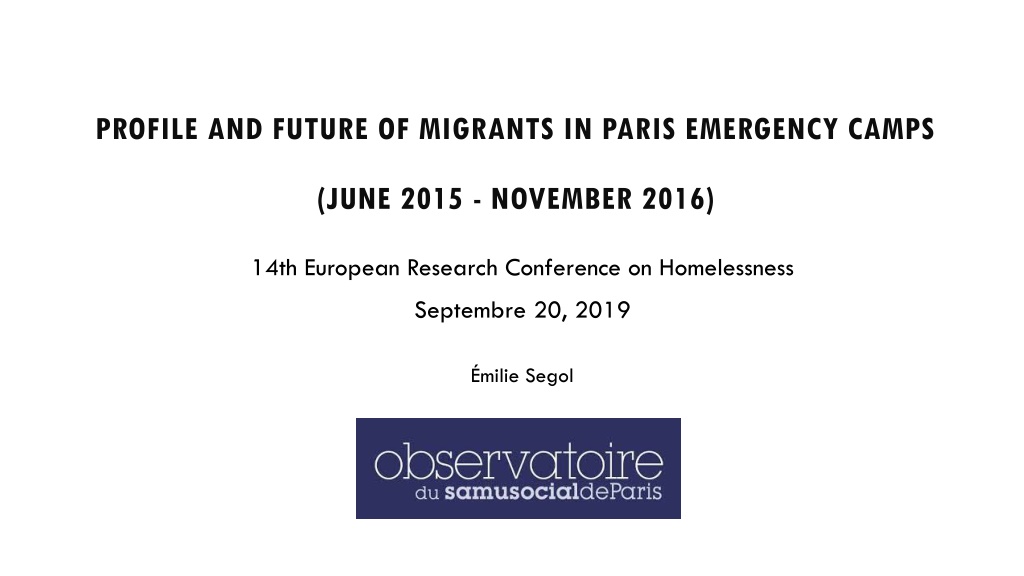
 undefined
undefined





